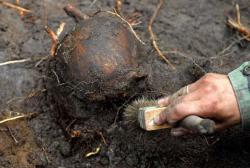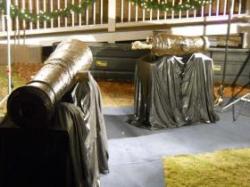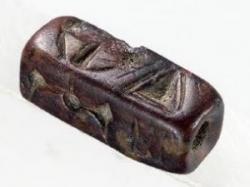18 NOVEMBRE
INDI-UNI : ANTHROPOLOGY - ARCHAEOLOGY
INSCRIPTION 2011 – 2012 COURS A DISTANCE
REGISTRATION 2011 – 2012 ONLINE COURSES
POLOGNE –  –Olecko - Archaeologists believe that the remains of soldiers who died after Napoleon's doomed march on Moscow have been found during the creation of a new bypass at Olecko, north east Poland. The skeletons of some 350 people were discovered in the forgotten graveyard, after woodland was cut back to lay the new road. “Analysis of the bones of several men buried there shows changes characteristic of people who rode on horseback for much of their lives,” archaeologist Hubert Augustyniak told the Polish Press Agency. About half of those buried were children, and experts believe that they were from the local village. Tests confirm that the villagers suffered from a poor diet and were exposed to hard labour. A number of coins minted between the years 1710 and 1842 was also found at the site, as well as some jewellery and an iron cross. It is believed that the soldiers' uniforms were stolen. Some 400,000 French troops – many of them Poles hoping for the complete rebirth of their country - are estimated to have died during Napoleon's Moscow campaign. Napoleon had created the so-called Duchy of Warsaw in 1807, and called the 1812 war his “second Polish campaign.” However, the retreat from the Russian capital in the winter of 1812/1813 left victims strewn across much of Eastern Europe. The defeat marked the beginning of the end both for Bonaparte and the empire that he had created.
–Olecko - Archaeologists believe that the remains of soldiers who died after Napoleon's doomed march on Moscow have been found during the creation of a new bypass at Olecko, north east Poland. The skeletons of some 350 people were discovered in the forgotten graveyard, after woodland was cut back to lay the new road. “Analysis of the bones of several men buried there shows changes characteristic of people who rode on horseback for much of their lives,” archaeologist Hubert Augustyniak told the Polish Press Agency. About half of those buried were children, and experts believe that they were from the local village. Tests confirm that the villagers suffered from a poor diet and were exposed to hard labour. A number of coins minted between the years 1710 and 1842 was also found at the site, as well as some jewellery and an iron cross. It is believed that the soldiers' uniforms were stolen. Some 400,000 French troops – many of them Poles hoping for the complete rebirth of their country - are estimated to have died during Napoleon's Moscow campaign. Napoleon had created the so-called Duchy of Warsaw in 1807, and called the 1812 war his “second Polish campaign.” However, the retreat from the Russian capital in the winter of 1812/1813 left victims strewn across much of Eastern Europe. The defeat marked the beginning of the end both for Bonaparte and the empire that he had created.
http://www.thenews.pl/1/9/Artykul/58737,Napoleonic-soldiers-remains-found-in-northern-Poland
USA –  St. Augustine - Archaeologists unveiled two centuries-old cannons, one with a very important inscription, at the St. Augustine Lighthouse and Museum. One cannon is a four pound long gun, named because it could fire cannon balls that weighed up to four pounds. The second cannon, the shorter one, is a more powerful carronade, also referred to as a gunnade. Carronades were invented in Scotland during the time of the American Revolution. The shorter cannon has the date 1780 inscribed on its side. From the cannon’s date and other artifacts found at the site, LAMP archaeologists believe that the cannons could belong to one of a series of loyalist transport ships that wrecked in the area. Around 16 loyalist ships sunk as they were seeking refuge after the British evacuated Charleston in 1782. At the time, St. Augustine was a British-occupied city. That is just a hypothesis at this point, Meide said. The shipwreck could be also merchant ship.The shipwreck has also produced five cauldrons, a gentleman’s pocket pistol and a ship’s bell.
St. Augustine - Archaeologists unveiled two centuries-old cannons, one with a very important inscription, at the St. Augustine Lighthouse and Museum. One cannon is a four pound long gun, named because it could fire cannon balls that weighed up to four pounds. The second cannon, the shorter one, is a more powerful carronade, also referred to as a gunnade. Carronades were invented in Scotland during the time of the American Revolution. The shorter cannon has the date 1780 inscribed on its side. From the cannon’s date and other artifacts found at the site, LAMP archaeologists believe that the cannons could belong to one of a series of loyalist transport ships that wrecked in the area. Around 16 loyalist ships sunk as they were seeking refuge after the British evacuated Charleston in 1782. At the time, St. Augustine was a British-occupied city. That is just a hypothesis at this point, Meide said. The shipwreck could be also merchant ship.The shipwreck has also produced five cauldrons, a gentleman’s pocket pistol and a ship’s bell.
http://staugustine.com/news/local-news/2011-11-18/cannons-reveal-clue-about-centuries-old-shipwreck-site
FRANCE – Saclay - L'Etablissement public Paris-Saclay (EPPS), chargé de l'aménagement du futur campus sur le plateau de Saclay, et l'Institut national de recherches archéologiques préventives (Inrap) ont signé vendredi à Orsay (Essonne) un accord-cadre portant sur les recherches archéologiques sur le site. A ce jour, 300 hectares ont été diagnostiqués et 25 hectares fouillés sur le plateau de Saclay par les chercheurs de l'Inrap, a rappelé son directeur général. Les chercheurs ont ainsi pu mettre au jour des "vestiges archéologiques, dans certains cas particulièrement bien conservés", selon Olivier Blin, archéologue et responsable scientifique pour la région, qui cite notamment la découverte d'un village du Premier Age de fer à Gif-sur-Yvette (Essonne), un site "tout à fait exceptionnel, quasiment unique à l'heure actuelle en Ile-de-France".
http://www.europe1.fr/France/Saclay-accord-pour-des-fouilles-archeo-822725/
FRANCE – Blanzac - "Suite aux tranchées qui ont été réalisées systématiquement sur le tracé de la future LGV, le préfet de région a décidé des fouilles sur les lieux qui présentent un intérêt scientifique majeur. Dans la commune de Blanzac, deux sites donnent lieu à des recherches», précise Sébastien Joly, coordinateur des fouilles archéologiques sur le projet Tours-Bordeaux. À l'entrée du bourg, le long de la route de Villebois-Lavalette, des cabanes de chantier ont été installées et une pelleteuse est au travail sur une parcelle de 22.000 m2. Claire Mitton dirige le chantier effectué pour le compte du groupement Liséa, concessionnaire des travaux. À cet endroit, les recherches archéologiques concernant des constructions du Haut Moyen Âge devraient durer jusqu'au mois de février. «Il s'agit pour le moment d'un décapage qui précède le travail proprement scientifique.» «Pour l'autre site, il s'agit d'un espace plus restreint de 7.000 m2. Les fouilles, conduites par l'Inrap [Institut national de recherches archéologiques préventives], ne commenceront qu'au mois de janvier. Il s'agit de recherches concernant la période néolithique-protohistoire et c'est un lieu sur lequel s'est déroulée une extraction à ciel ouvert.» Les deux endroits livreront des renseignements précieux concernant le passé du Blanzacais et donneront lieu à des présentations au public.
http://www.charentelibre.fr/2011/11/18/les-fouilles-vont-bon-train-avant-la-lgv,1065505.php
GRECE –  Crete - A four-sided red jasper sealstone is among the finds unearthed during this season’s excavation of the Minoan peak sanctuary at Vrysinas, located south of the city of Rethymnon. The sealstone, which is carved on all four surfaces with characters of the Minoan Hieroglyphic script, constitutes the sole evidence to date for the presence of this earliest Minoan style of writing in Western Crete. The excavation, which began in 2004, is conducted by the Ephorate of Prehistoric and Classical Antiquities under the supervision of the archaeologist Helena Papadopoulou in collaboration with Prof. Iris Tzachili from the Department of History and Archaeology of the University of Crete. A preliminary study of the artefacts recovered thus far - including some 800 clay votive statuettes and a significant number of ceramic vessels - indicates that the peak sanctuary was in use throughout the First Palace period (1900-1700 BC) and continued until at least the beginning of the New Palace phase, after which time it was relocated to a lower part of the plateau. The Vrysinas sanctuary is believed to have been the most sacred peak in Western Crete. The site’s undeniable ritual context puts it on a par with other important Minoan peak sanctuaries like those at Iouktas, Petsofas and Traostalos Kofinas in central and eastern Crete.
Crete - A four-sided red jasper sealstone is among the finds unearthed during this season’s excavation of the Minoan peak sanctuary at Vrysinas, located south of the city of Rethymnon. The sealstone, which is carved on all four surfaces with characters of the Minoan Hieroglyphic script, constitutes the sole evidence to date for the presence of this earliest Minoan style of writing in Western Crete. The excavation, which began in 2004, is conducted by the Ephorate of Prehistoric and Classical Antiquities under the supervision of the archaeologist Helena Papadopoulou in collaboration with Prof. Iris Tzachili from the Department of History and Archaeology of the University of Crete. A preliminary study of the artefacts recovered thus far - including some 800 clay votive statuettes and a significant number of ceramic vessels - indicates that the peak sanctuary was in use throughout the First Palace period (1900-1700 BC) and continued until at least the beginning of the New Palace phase, after which time it was relocated to a lower part of the plateau. The Vrysinas sanctuary is believed to have been the most sacred peak in Western Crete. The site’s undeniable ritual context puts it on a par with other important Minoan peak sanctuaries like those at Iouktas, Petsofas and Traostalos Kofinas in central and eastern Crete.
http://greece.greekreporter.com/2011/11/17/earliest-sample-of-minoan-hieroglyphics-found-in-western-crete/
ROYAUME UNI - Priddy Circles - They were ancient stone rings made by Neolithic West Country man for prehistoric rituals and lasted over 4,000 years. But one swift bulldozing later, the South-west's Priddy Circles have been ruined forever, much to the anger of local residents, heritage experts, and the police. A man has been arrested and bailed in connection with the partial destruction of the set of four circular Bronze Age earthworks, near Wells, Somerset, believed to predate Stonehenge.
http://www.independent.ie/world-news/europe/arrest-made-in-ancient-stones-vandalism-probe-2939005.html
USA – Dillsburg - For eight weeks this summer, three archaeologists and a team of volunteers dug through several feet of dirt next to Dills Tavern in Dillsburg searching for the foundation of Matthew Dill’s original tavern that stood on the site as early as 1750. They didn’t find it, but their work turned up between 35,000 to 40,000 objects, many dating back to the Colonial days. Among their finds were 21 British copper coins, two Spanish silver coins, a religious medal, many pieces of pottery, plaster, pieces of window glass and iron nails. The artifacts are being catalogued by archaeologist Steve Warfel, who was in charge of the excavation.
http://www.pennlive.com/west-shore/index.ssf/2011/11/dills_tavern_dig_turns_up_21_copper_coins.html